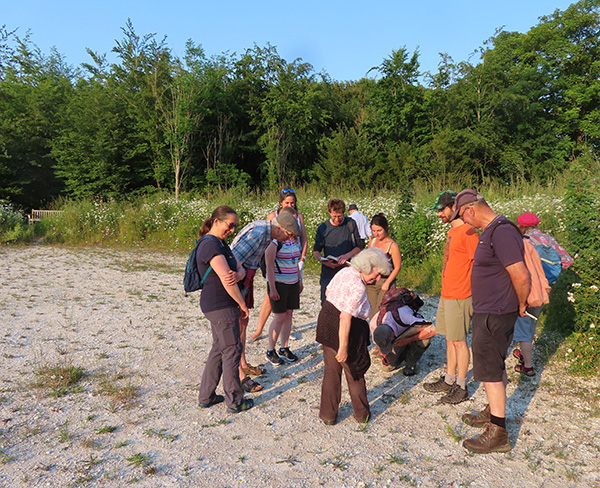
The week commencing 12 June was popular for group visits to Magog Down. On Tuesday (13 June), there was an unannounced visit by a Natural England Landscape Advisory Panel. Alastair Driver (a panel member) wrote on Twitter – “Think of the health and wellbeing benefits we could accrue if the majority of our urban and peri-urban greenspace was this beautiful and biodiverse”.
Two days later (15 June), Jonathan Shanklin (Botanical Society of Britain & Ireland Recorder for Cambridgeshire) took a group of Cambridge Natural History Society (CNHS) members on an evening walk on Magog Down, accompanied by Claire Beale, Conservation Ranger for the Magog Trust. Although originally planned as a walk along the arable margins on the eastern side of Magog Down searching for rarer arable plants, there was much to look at along the way and the group only managed a quick look on the field edge!
Participants on the walk were delighted to see the many Pyramidal Orchids Anacamptis pyramidalis which were just coming into bloom all over North Down. Pyramidal Orchid numbers continue to increase, and 2023 has been a bumper year, with plants established in all meadow areas of Magog Down, and some woodland rides.

The walk continued across North Down with frequent pauses to note and share information about the many meadow flowers. There was a chance to look at the North Down scrape with the contrasting areas, including the banks (upper image) and the scraped back inner area (lower image).


The image above shows Jonathan Shanklin and other CNHS members examining a plant on the bare chalk of the scrape.
The walk continued through Colin’s Paddock, with a chance to admire the bank of Common Rockrose Helianthemum nummularium and Horseshoe Vetch Hippocrepis comosa.

There was an opportunity to look on the bare soil corner of the nearby arable field. The group were pleased to find a number of rarer annual arable plants, including Dwarf Spurge Euphorbia peplus.

A memorable evening walk concluded with the sun setting over the Feoffee Field.

On the Friday evening (16 June), Rachel Bates from the Cambridgeshire Bat Group took a small group around the site, some with detectors. Rachel remarked, also on Twitter, “Lovely evening for a #bat walk tonight at @MagogDown. Quite quiet on the bat front but the faithful pips put on a brief show 🙂 And we did a bit of night-time botanising too!”
Rachel gave an introductory talk, including some bat facts and myths. There are over a thousand species of bat in the world, whereas the UK has just seventeen breeding species. Twelve of these breeding species can be found in Cambridgeshire. The walk was a chance to record bat species present at the Down. The walk the previous year detected Common and Soprano Pipistrelle, Noctule and Leisler’s bats.
The walk took a circular route including through and around woodland edges and alongside some open meadow areas. The detectors picked up bat activity early on the walk along the perimeter path next to Memorial Wood, with Pipistrelles foraging along the path in the opening between the trees. This year Pipistrelles could also be seen foraging over the meadows on the woodland edge, and a Noctule was also picked up by a detector.
Bats are good indicators of a healthy ecosystem. All UK bats are insectivorous and eat thousands of midges and mosquitoes. Each species has its own specialism and habitat. Bats are very vulnerable to change, and populations are in decline. Reasons for decline can be felling of trees which provide roosting sites, agricultural intensification which supports fewer insects and habitat loss and fragmentation. Rachel discussed the decline in bats sightings and records this year, suggesting that the wet cold spring might be a possible reason.
All photos by Claire Beale, except Pyramidal Orchid photo which was taken by Nick Beale.
